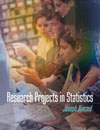Contents...… v |
| |
Preface...… ix |
| To the student |
| To the instructor |
| About the student examples |
| About the author |
| Acknowledgments |
| |
Overview...… 1 |
| 1.1 Motivation for the project…... 1 |
| Emphasis is shifting toward real data |
| Projects allow hands-on experiences |
| 1.2 Schedule for the project...… 2 |
| Course schedule |
| Project schedule |
| |
Group Communication...… 5 |
| 2.1 Purpose of the communication plan...… 5 |
| Group dynamics |
| Uses of the communication plan |
| 2.2 Contents of the communication plan...… 6 |
| Information content |
| Planning content |
| |
Project Ideas...… 8 |
| 3.1 Purpose of the list of ideas...… 8 |
| Start on the right track |
| Start with general thoughts |
| 3.2 Generating research questions...… 9 |
| Involve the entire group |
| Ask a question about a large group |
| Talk to experts |
| Use the Internet |
| Consider what will be recorded |
| Is the question describing, comparing, or relating? |
| 3.3 Requirements for the research project...… 11 |
| Everyone needs to be able to participate |
| There must be sampling |
| No opinion surveys |
| No duplicates |
| 3.4 Example of a list of ideas...… 12 |
| Example |
| |
The Research Proposal...… 14 |
| 4.1 Purpose of the research proposal...… 14 |
| Always begin with a plan |
| Be specific |
| Be complete |
| Be flexible |
| 4.2 Contents of the research proposal...… 15 |
| Good writing is essential |
| Required elements |
| 4.3 Examples of research proposals...… 18 |
| Example A - After-school programs in Nebraska City |
| Example B - Seeds in watermelon |
| |
Data Collection...… 23 |
| 5.1 Purpose of the data collection stage...… 23 |
| Answer the research question |
| Real data |
| 5.2 Characteristics of good dataIntegrity...… 24 |
| The meaning of integrity |
| Does the sample represent the population? |
| Do the variables relate to the issues? |
| 5.3 Characteristics of good dataAccuracy...… 25 |
| The meaning of accuracy |
| Counting |
| Measuring devices |
| Survey instruments |
| 5.4 Collecting the data...… 26 |
| Everyone must be involved |
| Use randomness to select the sample |
| Be courteous at all times |
| 5.5 The data collection report...… 27 |
| The data must be collected by the deadline |
| The process is the important part |
| 5.6 Examples of data collection...… 28 |
| Example A - After-school programs in Nebraska City |
| Example B - Seeds in watermelon |
| |
Data Analysis...… 32 |
| 6.1 Purpose of the data analysis...… 32 |
| Answer the research question |
| Randomness gives us the ability |
| 6.2 Types of data analysis...… 32 |
| Use the right tool |
| Is the question describing, comparing, or relating? |
| 6.3 Preparing the data for analysis...… 33 |
| Identify the variables |
| Organize the information into rows and columns |
| Use code numbers if necessary |
| 6.4 Examples of data analysis...… 35 |
| Example A - After-school programs in Nebraska City |
| Example B - Seeds in watermelon |
| |
Presenting the Results...… 41 |
| 7.1 The overall presentation...… 41 |
| Purpose of the final presentation |
| Elements of the final presentation |
| 7.2 The oral presentation...… 42 |
| Purpose of an oral presentation |
| Elements of an oral presentation |
| Style issues for the oral presentation |
| 7.3 The written report...… 44 |
| Purpose of a written report |
| Elements of a written report |
| Style issues for the written report |
| 7.4 Examples of written reports...… 45 |
| Example A - After-school programs in Nebraska City |
| Example B - Seeds in watermelon |
| |
Comments on Student Examples...... 54 |
| 8.1 Comments on the list of ideas...… 54 |
| 8.2 Comments on the research proposals...… 55 |
| Example A - After-school programs in Nebraska City |
| Example B - Seeds in watermelon |
| 8.3 Comments on the data collection...… 57 |
| Example A - After-school programs in Nebraska City |
| Example B - Seeds in watermelon |
| 8.4 Comments on the written reports...… 59 |
| Example A - After-school programs in Nebraska City |
| Example B - Seeds in watermelon |
| |
Index...... 65 |



 2004 McGraw-Hill Higher Education
2004 McGraw-Hill Higher Education

 2004 McGraw-Hill Higher Education
2004 McGraw-Hill Higher Education